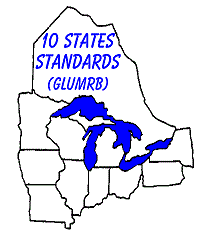10 States Standards
Environmental Health Division
10 States Standards
 Great Lakes - Upper Mississippi River Board (GLUMRB)
Great Lakes - Upper Mississippi River Board (GLUMRB)
Illinois - Indiana - Iowa - Michigan - Minnesota - Missouri - New York - Ohio - Ontario - Pennsylvania - Wisconsin
State and Provincial Public Health and Environmental Managers
The Great Lakes-Upper Mississippi River Board of State and Provincial Public Health and Environmental Managers (GLUMRB) in 1950 created a Water Supply Committee consisting of one associate from each state represented on the Board. A representative from the province of Ontario was added in 1978. The term state shall mean a representative state or the Province of Ontario.
Documents include the following:
- Policy Statements—Preceding the standards are policy statements of the Board concerning water works design, practice, or resource protection. Some policy statements recommend an approach to the investigation of innovative treatment processes which have not been included as part of the standards because sufficient confirmation has not yet been documented to allow the establishment of specific limitations or design parameters. Other policy statements recommend approaches, alternatives or considerations in addressing a specific water supply issue and may not develop into standards.
- Interim Standards—Following the policy statements are interim standards. The interim standards give design criteria which are currently being used for new treatment processes, but the use of the criteria is limited and insufficient for recognition as a recommended standard.
- Recommended Standards—The Standards, consisting of proven technology, are intended to serve as a guide in the design and preparation of plans and specifications for public water supply systems, to suggest limiting values for items upon which an evaluation of such plans and specifications may be made by the reviewing authority, and to establish, as far as practicable, uniformity of practice. Because statutory requirements and legal authority pertaining to public water supplies are not uniform among the states, and since conditions and administrative procedures and policies also differ, the use of these standards must be adjusted to these variations.
The terms shall and must are used where practice is sufficiently standardized to permit specific delineation of requirements or where safeguarding of the public health justifies such definite action. Other terms, such as should, recommended, and preferred, indicate desirable procedures or methods, with deviations subject to individual consideration.
Most quantified items in this document are cited in US customary units and are rounded off at two significant figures. Metric equivalent quantities, also rounded off at two significant figures, follow in brackets where compound units are involved. The metric unit symbols follow International System conventions. In the event of a conflict between quantities in US units and the metric equivalent the quantity in US units shall take precedence.
It is not possible to cover recently developed processes and equipment in a publication of this type. However, the policy is to encourage, rather than obstruct, the development of new processes and equipment. Recent developments may be acceptable to individual states if they meet at least one of the following conditions:
- have been thoroughly tested in full scale comparable installations under competent supervision,
- have been thoroughly tested as a pilot plant operated for a sufficient time to indicate satisfactory performance, or
- a performance bond or other acceptable arrangement has been made so the owners or official custodians are adequately protected financially or otherwise in case of failure of the process or equipment.
The Board recognizes that many states, other than those of the Great Lakes-Upper Mississippi River Board of State and Provincial Public Health and Environmental Managers, use this as part of their design requirements for water works facilities. The Board welcomes this practice as long as credit is given to the Board and to this publication as a source for the standards adopted. Suggestions from non-member states are welcome and will be considered.